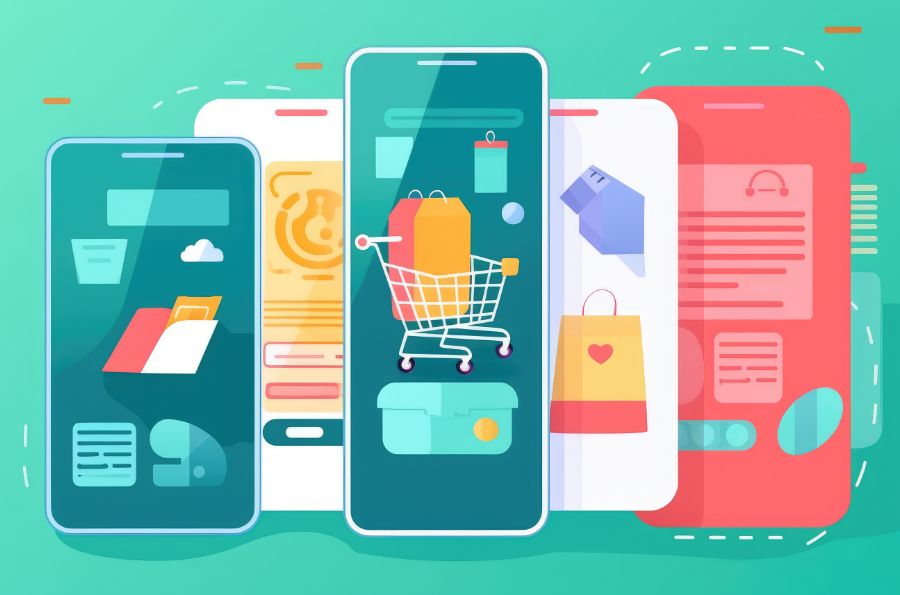In an era where mobile technology dominates the digital landscape, consumer apps have become a driving force in how people interact with brands, shop, and manage daily tasks. These apps go beyond convenience—they serve as strategic tools for businesses to enhance customer engagement, boost brand loyalty, and streamline operations.
This article will delve into the core aspects of consumer apps, highlighting the essential features that define a successful application. Whether you’re looking to develop a new app or improve an existing one, understanding these key elements will help you leverage mobile technology effectively and stay competitive in the ever-evolving digital marketplace.
What Are Consumer Apps?
Consumer apps are mobile applications specifically designed to meet users’ individual needs and preferences. They aim to provide a smooth and engaging user experience, particularly in shopping and service interactions. Businesses invest in these apps to build stronger relationships with customers and drive sales through more efficient interactions.
The modern business landscape sees consumer apps as crucial for maintaining customer loyalty and enabling easy transactions. Popular examples include social media platforms like Facebook, Instagram, and Twitter; entertainment apps such as Candy Crush and Among Us; and comprehensive “super apps” like Grab, Uber, and Trivago. The download statistics are telling: in 2020, there were around 218 billion app downloads, highlighting the central role of consumer apps in our daily lives.
These apps also vitally collect user data, which helps businesses tailor their marketing strategies and improve customer engagement. Ultimately, consumer apps are key to making the digital marketplace more user-friendly and efficient, seamlessly connecting users with businesses.
Consumer App Categories
Consumer apps come in various forms, each catering to specific aspects of our daily lives. They can be broadly categorized into several groups, including:
- Social Media Apps: Platforms like Facebook, Instagram, and Twitter dominate this category, providing spaces for users to connect, share, and communicate with others globally.
- Entertainment and Gaming Apps: This category includes gaming apps such as Candy Crush and Among Us, as well as streaming services for music, movies, and television shows.
- E-commerce and Shopping Apps: Apps that facilitate online shopping, such as Amazon and eBay, belong to this category, making purchasing and selling goods and services online a breeze.
- Lifestyle and Utility Apps: These apps range from health and fitness trackers to recipe books and weather updates, assisting users in managing their personal lives.
- Travel and Navigation Apps: With apps like Google Maps, Uber, and Trivago, users can plan trips, book accommodations, or navigate through unfamiliar cities.
- Productivity and Business Apps: Apps like Slack, Asana, and Trello help users organize their work, manage projects, and collaborate with teams remotely.
- News and Education Apps: Apps that aggregate news, offer educational content, or provide learning platforms, such as Coursera or Duolingo, are included in this category.
- Finance and Banking Apps: These apps help users manage their finances, including mobile banking, budget tracking, and investment advice.
Each of these categories serves a distinct purpose but shares the common goal of enhancing the user experience through convenience and accessibility. As businesses continue to recognize the value of consumer apps, they are becoming more innovative, often blending features from different categories to better serve their customers.
Benefits of Consumer Apps
The advantages of consumer apps are manifold, impacting both the user experience and a business’s bottom line:
- Convenience for users: These apps simplify life by providing instant access to services and information. Users can perform a variety of tasks from their mobile devices, eliminating the need for physical transactions.
- Personalized engagement: Consumer apps allow for a high degree of personalization. By using user data, apps can tailor content, make suggestions, and send notifications that resonate with individual preferences, increasing user interaction and satisfaction.
- Business reach and customer retention: Through features like in-app loyalty programs, businesses can encourage repeat visits and purchases. This not only helps in retaining customers but also extends a brand’s reach by incentivizing users to share their positive experiences.
- Strategic data collection: Apps are a goldmine of user data, which businesses can analyze to gain insights. This data guides strategic decisions, refines marketing campaigns, and enhances product offerings.

Key Features of Successful Consumer Apps
A consumer app that captures attention and retains users typically includes several critical features:
- Intuitive User Interface: The app should be easy to navigate, with a clean design that makes finding products and services straightforward. This simplicity enhances the user experience and encourages longer engagement times.
- Customized Experience: Personalization algorithms that suggest products based on browsing and purchase history can make shopping more relevant and efficient for users. This tailored approach means users are more likely to find what they want, increasing their satisfaction and loyalty.
- Price Check: A top consumer demand, according to eMarketer, is the ability to check prices. This feature empowers buyers to make cost-effective decisions quickly. It also fosters trust and transparency between the customer and the business.
- Stock Availability Alerts: It’s essential for customers to know if products are in stock, both in-store and online. Displaying stock levels can prompt immediate purchases and encourage customers to return when products are restocked. Apps like ConnectPOS exemplify this by allowing shoppers to add out-of-stock items to their cart and notify them upon restocking.
- Store Locator : An interactive store map can guide customers to physical locations effortlessly, which is particularly useful for new or remodeled stores. Easy navigation enhances customer perception and brand image.
- Loyalty and Reward Points Tracking: Reward points after purchases effectively foster customer loyalty. They incentivize repeat business by offering customers future discounts and benefits.
- Offline Mode: The ability for a mobile app to function without an internet connection, or in ‘offline mode,’ is a significant value-add. This can include saving shopping carts and viewing them offline, with seamless transition back to online shopping once the connection is restored.
- Secure and Diverse Payment Options: Providing a variety of payment methods, along with robust security measures, ensures that users can transact with confidence. This is crucial for converting browsing into actual sales.
- Responsive Customer Support: Efficient and easily accessible customer service within the app helps to quickly resolve issues. This support is key to maintaining user trust and enhancing the overall customer experience.
- Social Integration: Features that allow users to share their purchases or favorite items on social media can act as organic marketing for the app. They also add a social dimension to the shopping experience, connecting users with their community.
These features collectively contribute to a successful consumer app by enhancing the user experience, ensuring convenience, and building customer loyalty.
Why Consider Progressive Web Apps (PWAs) for Consumer Apps?
53% of mobile website visits are given up if the webpage takes more than three seconds to load. Therefore, it is vital for websites to get rid of friction and make users’ experience smoother. That’s when PWA came as a savior.
Progressive Web Apps (PWAs) offer a blend of the best features from both web and mobile apps, and they are becoming an increasingly popular choice for consumer app development due to several compelling reasons:
- Seamless Installation: PWAs do not require users to download them from an app store. They can be added to a user’s home screen directly from a website, which simplifies the installation process and saves device storage.
- Fast Performance: PWAs are designed to be fast. They load quickly, even on flaky internet connections, and provide smooth scrolling and animations, which can enhance user experience and engagement.
- Offline Accessibility: With service workers, PWAs can work offline or on low-quality networks. This feature ensures that users can access content and perform certain functions without an active internet connection.
- Automatic Updates: Unlike traditional apps that require users to manually update them, PWAs update themselves whenever the user visits the app. This ensures that all users have the latest version without any extra steps.
- Device and Platform Agnosticism: PWAs run in a web browser, which means they work across all devices and platforms using a single codebase. This universality can significantly reduce development and maintenance costs.
- Improved Engagement: Features like push notifications help PWAs to engage with users effectively, driving re-engagement and increasing conversion rates.
- Enhanced Security: PWAs are served via HTTPS, ensuring that all data transmitted is secure and resistant to tampering and snooping.
- Linkable and Shareable: The URL structure of PWAs makes them easily shareable and linkable, which is great for marketing and SEO purposes.
- Choosing to develop a PWA for consumer app can be a strategic decision that combines the discoverability of the web with the user-friendly qualities of an app, potentially leading to higher user retention and satisfaction.
ConnectPOS: Revolutionizing Retail with PWA Technology
Customer satisfaction sits at the heart of modern retail success. Adopting a consumer app transcends mere market trends, becoming a catalyst for deepening customer connections and propelling your sales to new heights.
Why Choose ConnectPOS?
Are you ready to elevate your retail experience?
ConnectPOS proudly presents our state-of-the-art Progressive Web App (PWA) designed with your shopping journey in mind. This app isn’t just another tool; it’s a comprehensive solution that promises to revolutionize the way you engage with customers.
Here’s what sets our PWA consumer app apart:
- Instantaneous QR code access: Step into the future with seamless entry to the app via a quick QR code scan—no tedious typing or waiting involved.
- Barcode product insights: Arm your customers with the power to unlock a wealth of product knowledge just by scanning a barcode, delivering convenience and informed purchasing.
- Never miss a sale: The fear of missing out is a thing of the past! Our app allows shoppers to reserve out-of-stock items, ensuring they always get what they come for.
- Tailored shopping experience: With intelligent algorithms, our app curates personalized product recommendations that resonate with individual customer tastes and buying habits.
- Easy self-check-out: Long queues are no more. Our app’s intuitive self-checkout process means customers can breeze through purchases with time to spare.
In a digital age where over 70% of consumers prefer mobile app shopping, ConnectPOS answers the call. We’re not just keeping pace with expectations—we’re setting new standards. The ConnectPOS PWA consumer app is meticulously designed to deliver a seamless, feature-laden shopping platform that aligns with the convenience modern shoppers seek.
Take the first step toward revolutionizing your retail operations with ConnectPOS. Our PWA consumer app is designed to create a seamless, fast, and engaging shopping journey, ensuring customers enjoy a superior omnichannel experience.
Book a live demo today and see firsthand how ConnectPOS can streamline transactions, enhance customer engagement, and boost sales for your business. Don’t just keep up with retail trends—lead the way with innovative POS technology!



